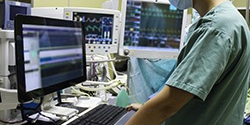The influence of artificial intelligence in the field of medicine has increased in recent years due to advances in learning algorithms, increased computing power of computers, and the availability of a huge amount of data due to the development of cloud technologies. Thanks to AI technology, it is possible to collect, analyze and transmit large amounts of data for predicting and detecting diseases, as well as making clinical decisions. AI can help in assessing the onset of the disease, treating and/or alleviating complications, helping to care for the patient during treatment or procedure, in research aimed at identifying and treating diseases.
Experts predict that the introduction of AI technologies could reduce annual health care costs in the United States by $150 billion in 2026.
These reductions will be associated to a greater extent with a change in the approach in the healthcare model, namely, a shift in focus to preventive medicine rather than the treatment of diseases.
AI technologies can have an impact in various fields of medicine, such as clinical, diagnostic, rehabilitation, surgical, prognostic practice, as well as in making clinical decisions and diagnosing diseases.
Prognostic medicine
Because AI can identify meaningful relationships in raw data, it can support diagnostic, treatment, and predictive outcomes in many medical situations. This allows medical professionals to apply the proactive treatment at the beginning of the disease. Artificial intelligence is already being used to more accurately detect diseases such as early-stage cancer, early-stage heart disease, prediction of Alzheimer’s disease in healthy people, as well as eye diseases, diabetes, and some genetic diseases. For example, Google’s Verily is an application designed to predict hereditary and non-contagious genetic diseases.
Clinical decision-making
Artificial intelligence applications can help doctors and medical researchers in the clinical decision-making process. The information generated by artificial intelligence systems allows medical professionals to make high-quality scientifically-based decisions in a particular case: choose a more appropriate procedure or examination, prescribe the best medicine, etc. For example, artificial intelligence can be used to calculate target areas for radiation therapy of the head and neck, reducing the risk of unnecessary radiation exposure of the patient. Artificial intelligence systems can also help doctors by providing a second opinion about a patient’s diagnosis or possible treatment.
Automated image diagnostics
Artificial intelligence helps in processing various medical images such as X-rays, magnetic resonance imaging, and computed tomography. With the help of deep learning technologies based on data and classification, AI makes it faster and more accurate, which greatly facilitates the work of diagnosticians. Some of the artificial intelligence applications that are already used in image diagnostics are Zebra Medical Vision, GE Health care, VRAD, Aidoc.
Personalized medicine
Personalized medicine is based on preventive care, relying on patient data collected from wearable devices, electronic health systems, genetic information and lifestyle. Artificial intelligence helps in identifying potential risks and, when they are detected, offers preventive measures.
Robotics and artificial intelligence-based devices
The development of artificial intelligence has led to a breakthrough in the development of robotic applications. These include robots used for surgical procedures, assistant robots for rehabilitation and patient care, robots integrated into implants and prostheses, as well as robots used to assist doctors and other medical personnel in performing their tasks. AI-based devices can be used in neuroprosthetics, as well as cognitive assistants (rehabilitation and training of the patient’s cognitive skills), and social and emotional stimulation (companion robots).
Chatbots based on artificial intelligence
Chatbots are the most commonly used artificial intelligence technology in the healthcare industry today due to the ease of implementation and lack of large time expenditures, unlike traditional methods of customer service. Chatbots use natural language processing (NLP), sentiment analysis, deep learning, machine learning, and algorithms to instantly respond and communicate with patients about paying bills and making doctor appointments.
Virtual Assistant
Unlike an artificial intelligence-based chatbot, a virtual assistant provides consistent support to patients at each stage of their treatment, rather than one-time answers to questions.
Virtual assistants also support administrative staff by optimizing work processes and automating routine tasks.
Automation
Since the advent of EMR’s (Electronic Medical Records), large databases of information about each patient have been created, which together can be used to determine trends in healthcare. EMR databases contain a huge layer of data on the history of hospital visits, records of diagnoses and interventions, laboratory tests, medical images and clinical descriptions. All these data sets can be used to build predictive models using AI, which will help clinicians in diagnosis and treatment decisions.
Artificial intelligence can play a revolutionary role in healthcare, as it can bring significant improvements in various areas, such as data management, automation of routine tasks, cost reduction, improved accessibility, acceleration of clinical research, and drug development.
In addition to the advantages, there are also some challenges to the introduction of AI technologies in the healthcare sector. First of all, these are safety, ethics, and confidentiality of patient data, as well as high implementation costs, lack of technical skills, insufficiently structured data, and lack of public trust.
Despite the existing risks and challenges, it is obvious that robotics and artificial intelligence have a huge impact on the global health ecosystem. According to experts, artificial intelligence-based technologies will play a leading role in many areas of healthcare in the next 5-10 years, providing earlier diagnosis, individual treatment, and more effective follow-up.





